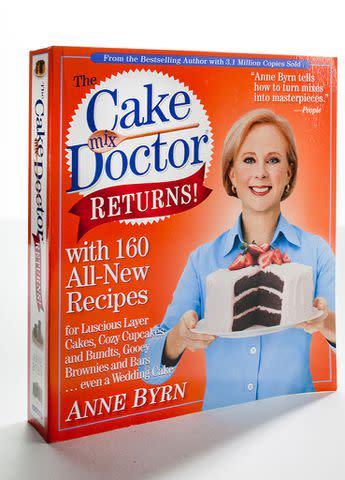The Lessons We Can Still Learn From The Cake Mix Doctor
They don't call her the doctor for nothing.

Getty Images/Randy Quan
My copy of The Cake Mix Doctor is a hand-me-down from my grandmother. It’s likely the first cookbook I cooked out of, somewhere around age five. It’s stained, torn, and annotated with my grandma’s own hot tips (typically a suggestion to double the liquor added).
The best-selling cookbook was first published in 1999, after author Anne Byrn, aka the Cake Mix Doctor, published a very popular article in The Tennessean about doctoring cake mixes.
Byrn, a Georgia native, has had a long and wide-ranging career in food writing. She served as a food editor at The Atlanta Constitution-Journal, studied classic French cooking in Paris, and even interviewed Julia Child. But she’s arguably most known for her cake mix cookbooks, which transform reliable baking mixes into desserts that taste so good, you’ll swear the results are homemade.
And the advice it contains, 24 years later, is still some of the best baking wisdom you’ll find, especially if you aren't a baker. Here are just a few lessons from The Cake Mix Doctor that will change how you bake with cake mixes (because we all do).
Pick the Right Mix
Cake mix ingredient lists read like a chemistry textbook, but reading those lists closely can help you pick a better cake mix for you. As Byrn points out, some mixes contain animal fats, such as lard or beef fat, which aren't suitable for everyone's dietary restrictions.
She also suggests sampling a few mixes before selecting the one to ultimately frost and serve, as each manufacturer makes their products differently. For example, Byrn notes how some yellow cake mixes can have an underlying coconut flavor, while some white cake mixes can have a cherry flavor.
Sour Cream Is Supreme
Whether in frosting or cake batter, sour cream comes up again and again in her recipes. While cake mixes seldom call for more than oil, eggs, and water, Byrn’s addition of sour cream takes boxed cakes to a whole new level.
As she notes, the sour cream adds an acidic tang to the batter, which is nice for balancing out the sometimes overbearing sweetness of the mixes. It also contributes to a more moist crumb.
Go Bold or Boozy
Cake mixes have a distinct taste. It might be nostalgic for some, but for others it’s a deal breaker and comes off too artificial. Byrn attributes this flavor to the vanillin used in most commercial mixes for vanilla flavor.
Bryn adds extracts, alcohol, and other bold, flavorful ingredients to the batter to override that "cake mix" taste. A splash of black coffee can do the trick in chocolate cake. In other mixes you can turn to almond extract, citrus zest, or a few tablespoons of rum or bourbon.

Getty Images/ MCT
Use Salted Butter
Most cakes rely on vegetable oil, but for more flavor you can use melted butter instead.
If you are going to use butter, go with salted. Although unsalted butter is the default in homemade baking, Byrn says the added salt can help balance out the sweetness of cake mixes for a more homemade taste. Even if you aren’t using butter in the mix, opt for salted butter in the frosting.
Chocolate Cake Mixes Need More Chocolate
Chocolate cake mixes can be a little lackluster when it comes to the chocolate flavor. Although devil’s food is often the most intensely chocolate-flavored of the bunch, even those mixes could use a boost. Byrn's recipes often suggest adding a few tablespoons of melted chocolate or unsweetened cocoa powder to the batter to deliver chocolate flavor closer to that of homemade cakes. It’s an easy addition that makes a huge difference.
Always Make Frosting From Scratch
The sort of reverence Byrn has for cake mixes doesn’t extend to store-bought frostings, and for good reason. A homemade American-style buttercream only requires a few ingredients and the flavor it delivers in comparison to the saccharine jarred stuff will be noticeable. So, while the boxed cake bakes, pull out a couple sticks of butter to soften on the counter—they’ll be room temperature by the time the cake is baked and cooled.
Much like how we revisited Byrn's cookbook classic, she did too, with her latest book, A New Take On Cake. Written during the pandemic from her kitchen table in Nashville, the book revisits some of her classic recipes and provides many new ones as well, all with updated techniques for modern bakers and modern cake mixes.
Related:Every Single Recipe in This Cookbook Starts with a Box of Cake Mix
For more Southern Living news, make sure to sign up for our newsletter!
Read the original article on Southern Living.

